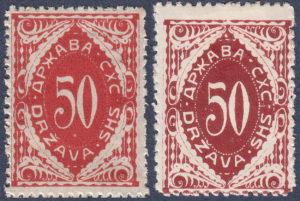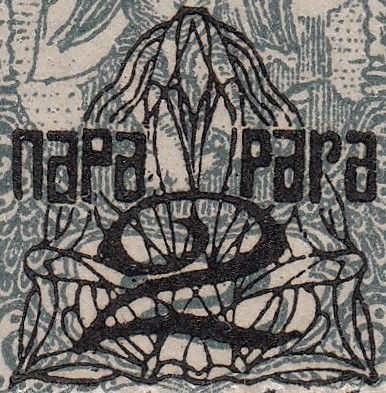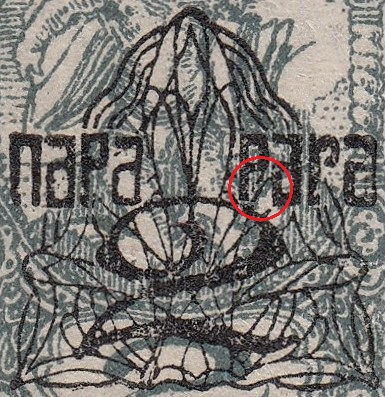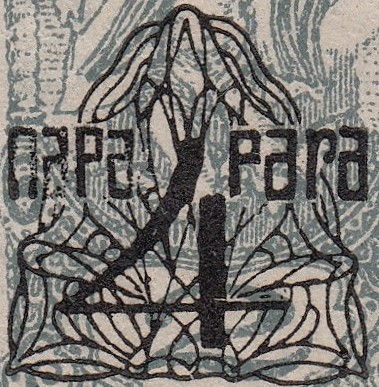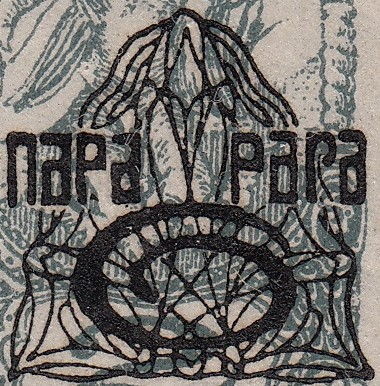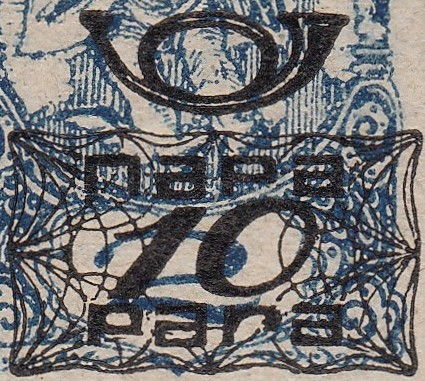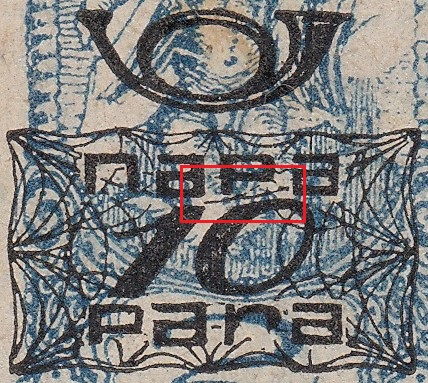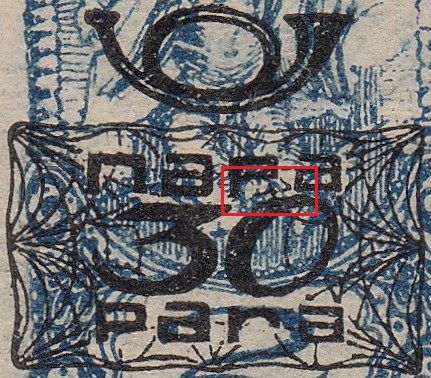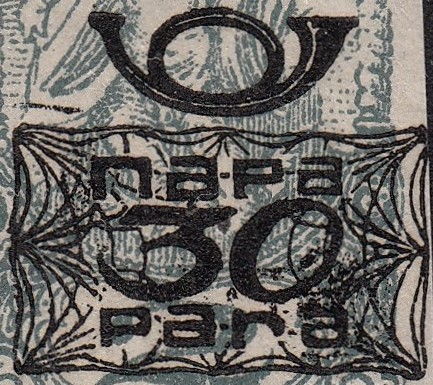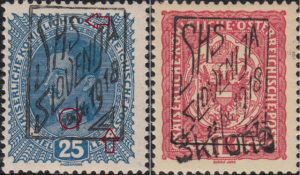Introduction
At the end of World War I, Slavic nations residing in the southernmost parts of the Austro-Hungarian Empire declared independence. The State of Slovenes, Croats and Serbs was proclaimed on 29 October 1918. The capital was Zagreb where the National Council (Narodno Vijeće) was residing. The State of S. C. S. remained internationally unrecognized. On 1 December 1918, unification with The Kingdom of Serbia was proclaimed and the Kingdom of Serbs, Croats, and Slovenes was formed.
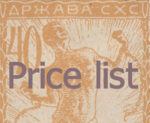 |
| Download the current price list here: Verigarji_Chainbreakers_2023 _Price_List.pdf (21 Mb) |
At the beginning, on the territory of the State of S. C. S., Astro-Hungarian krone was legal tender (100 heller/filler = 1 krone). In 1918 banknotes were stamped by the new authorities and they became State of S. C. S. krone, in 1919, after unification with the Kingdom of Serbia, new banknotes were printed where krone was converted to dinar at the rate of 1 dinar = 4 krone.
The State of S. C. S. was highly decentralized. After proclaiming independence, postal directorates ordered the overprinting of existing stocks of stamps in Croatia and Bosnia-Herzegovina. Printing of new stamps to be used on the whole territory of the State (Slovenia, Croatia, Bosnia and Herzegovina, and Vojvodina) was ordered by the Postal Directorate in Ljubljana (Slovenia), hence the naming of the Slovenian editions.
The dire post-war situation and haste in which printing was prepared, resulted in an especially rich philatelic area. Chainbrakers (“Verigarji” or “Verižniki”, as they are locally called) offer endless possibilities for philatelic specialization. Although these editions were well-researched, many facts and circumstances related to them remain obscure to this day.
Austrian and Hungarian stamps were still in use when stamps of Slovenian editions were issued. That resulted in many mixed frankings. Also, as the stamps were in use on the whole territory of the State of S. C. S., mixed frankings with stamps from other parts of the State exist (SHS Croatia and SHS Bosnia and Herzegovina). On top, mixed frankings with stamps of Baranya, Temisioara, and Fiume (Rijeka) are also known.
Stamps of the Slovenian edition were officially in use until 15 April 1921, as on 16 January 1921, a general issue for the whole Kingdom of Serbs, Croats, and Slovenes (later Yugoslavia) came into use. But in practice, these stamps were postally used well in the year 1922.
Definitive issues
A. Denomination in krone
Background
Stamps were designed by prof. Ivan Vavpotič, painter and illustrator from Ljubljana. Printing of stamps was first entrusted to press Tiskarna Blaznikovi nasledniki in Ljubljana where the first editions were printed in lithography.
As the press Tiskarna Blaznikovi nasledniki was unable to deliver the required quantities in time the printing of stamps was entrusted also to Jugoslovanska tiskarna in Ljubljana, where stamps were printed in letterpress using plates created by the photo-chemigraphic artistic institute A. Krampolek in Vienna.
When press workers in Ljubljana went on strike, the Postal Directorate in Ljubljana ordered the manufacturing of printing plates for the letterpress printing technique at the same institute in Vienna and, in agreement with them, chose press A. Reisser in Vienna for printing stamps in letterpress.
Country name: Država S. H. S. / Држава С. Х. С.
Currency: 100 vinar = 1 krone
Differentiating between Ljubljana and Vienna letterpress
Stamps were printed in three printing offices and in two techniques. Early attempts to differentiate between Ljubljana and Vienna letterpress prints were troublesome as there was no solid ground on which this differentiation could be made. Under this so-called three-part classification stamps were classified into three groups: Ljubljana lithography, Ljubljana letterpress, and Vienna letterpress.
Contemporary philatelists agreed upon these issues being Ljubljana letterpress:
- Color nuances
- 5 vinar: yellowish green and olive green
- 10 vinar: brick-red
- 15 vinar: gray blue and slate blue
- 20 vinar: olive brown and dark brown
- 30 vinar: carmine and burgundy
- 50 vinar: green and dark blue-green
- 60 vinar: violet-blue, slate blue, dark violet
- 1 krone: vermilion
- 2 krone: blue
- 5 krone: dark pink
- Denominations of 50 and 60 vinar and 1, 2, and 5 krone were printed on thin paper, with gum being applied after the perforation process.
- All stamps with rouletting (perce en scie) perforation.
Stamps printed both in lithography and in letterpress
As it is impossible to fully differentiate between Ljubljana and Vienna letterpress, contemporary stamp catalogs use a two-part classification and differentiate only between lithography and letterpress as the two printing techniques can be easily identified.
| Differentiating between stamps printed in lithography and in letterpress | ||
|---|---|---|
| Lithography (Ljubljana) |
Letterpress (Ljubljana and Vienna) |
Description |
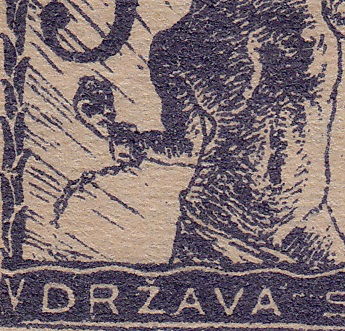 |
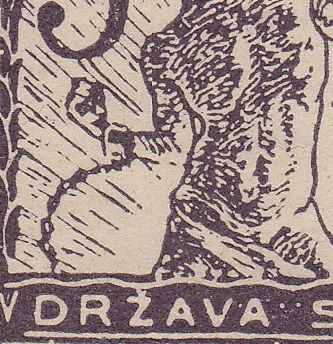 |
3 vinar Lithography:
Letterpress:
|
| Details | ||
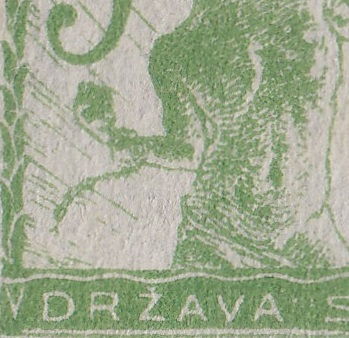 |
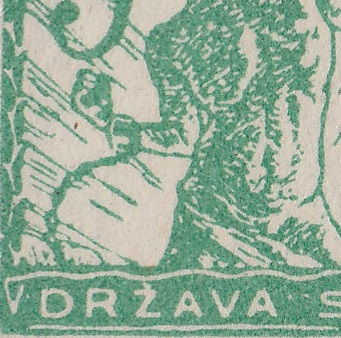 |
5 vinar Lithography:
Letterpress:
|
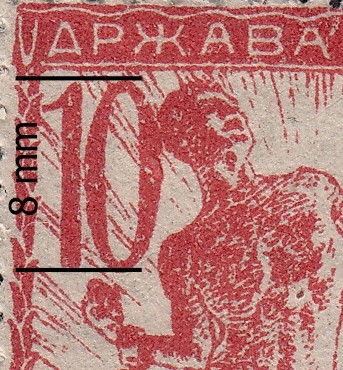 |
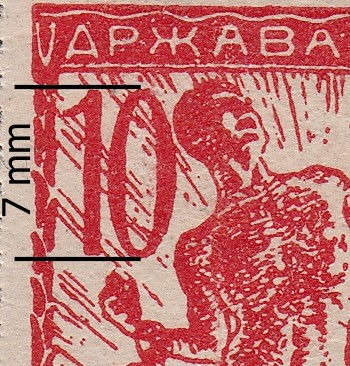 |
10 vinar Lithography:
Letterpress:
|
| Details | ||
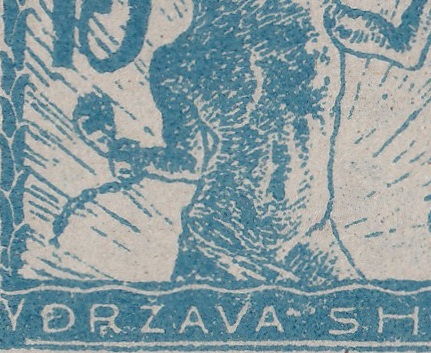 |
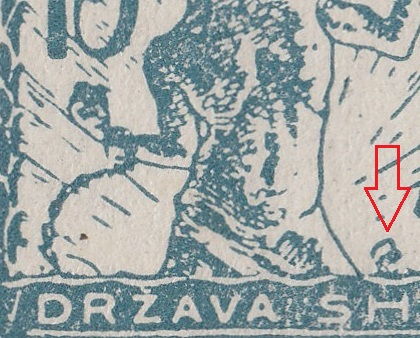 |
15 vinar Lithography:
Letterpress:
|
| Details | Details | |
 |
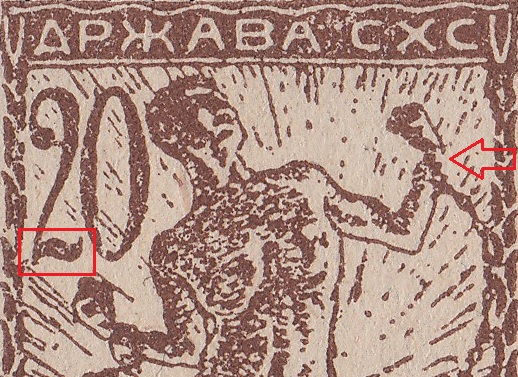 |
20 vinar Lithography:
Letterpress:
|
| Details | ||
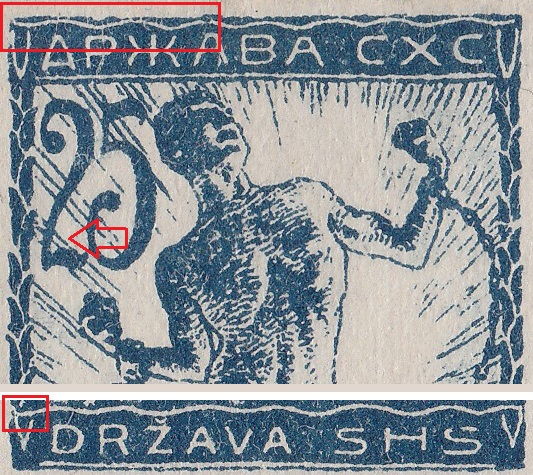 |
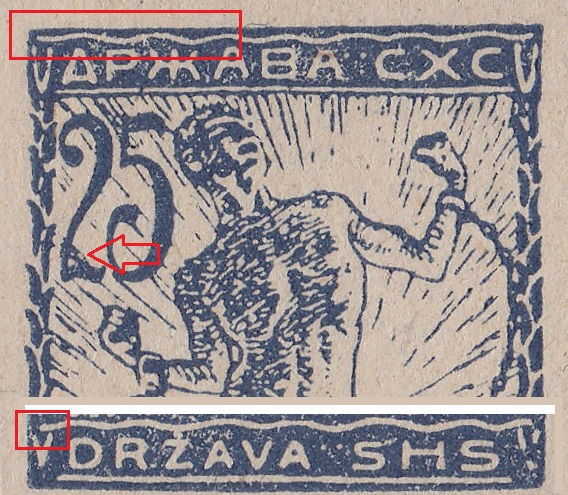 |
25 vinar Lithography:
Letterpress:
|
| Details | ||
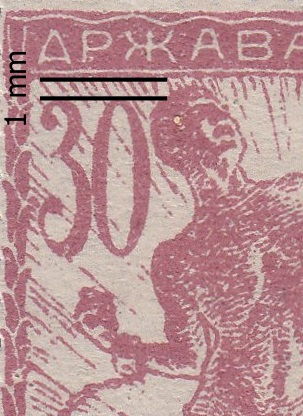 |
 |
30 vinar Lithography:
Letterpress:
|
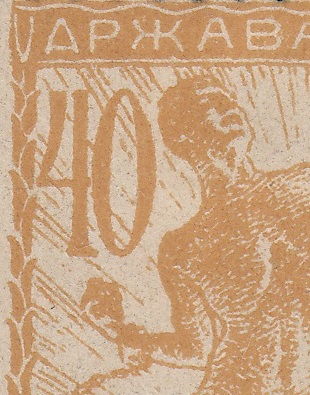 |
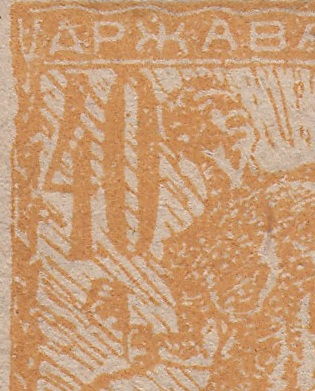 |
40 vinar Lithography:
Letterpress:
|
| Details | ||
| Stamps printed only in letterpress | |||||
|---|---|---|---|---|---|
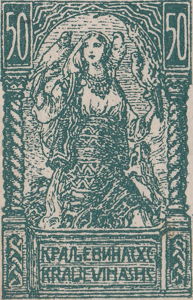 |
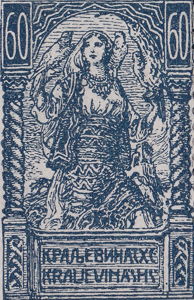 |
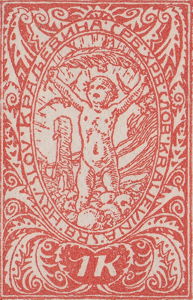 |
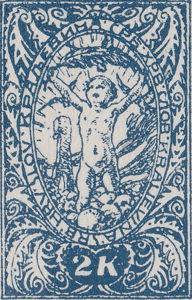 |
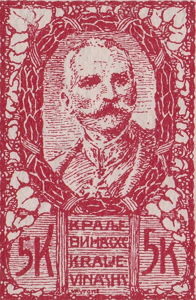 |
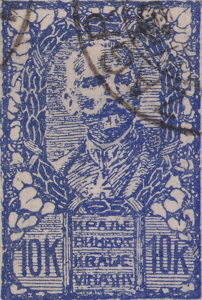 |
| Details | Details | Details | Details | Details | |
| Stamps printed in lithography only | |
|---|---|
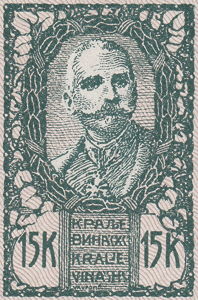 |
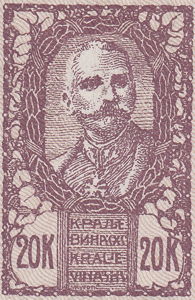 |
| Details | Details |
B. Denomination in dinars
On 24 June 1920, the Postal Directorate in Ljubljana started issuing stamps in new currency and state inscription. Stamps with denominations of 5, 10, 15, 20, 25, 40, 45, 50 and 60 para and 1 and 4 dinars were printed in letterpress. Values of 2, 6, and 10 dinars were printed in lithography. Stamps of 2 and 10 dinars were perforated line 11½, other stamps with rouletting (perce en scie).
Stamps with denomination in krone were still in circulation, and many mixed franking exist.
Country name: Kraljevina S. H. S. / Краљевина С. Х. С.
Currency: 100 para = 1 dinar
 |
| Note a design error on 2, 4, 6 and 10 dinara stamps: letter N instead of letter И in ДИНАРА. The inscription is correct only on 1 dinar stamp. |
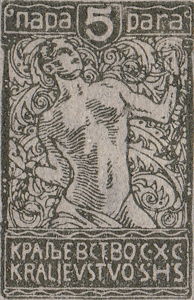 |
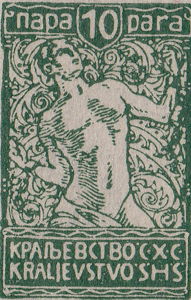 |
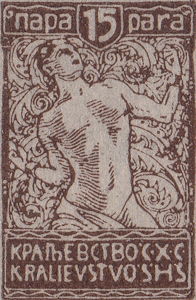 |
 |
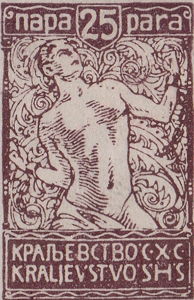 |
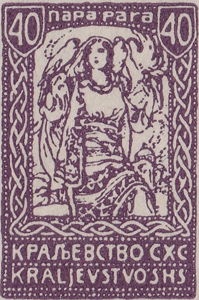 |
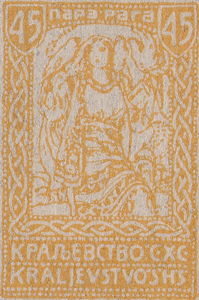 |
| Details | Details | Details | Details | |||
 |
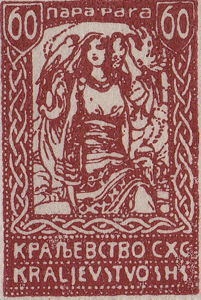 |
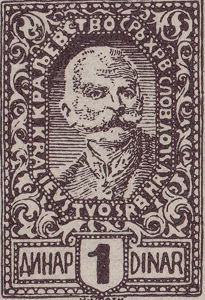 |
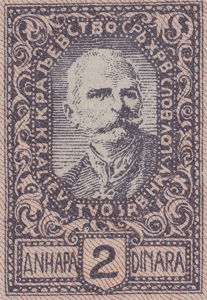 |
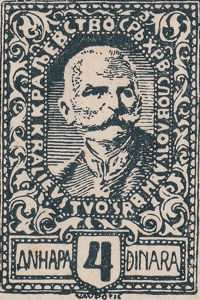 |
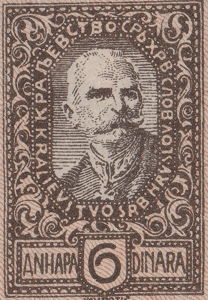 |
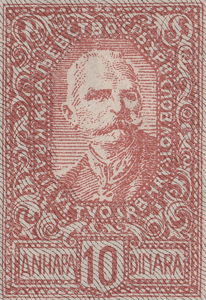 |
| Details | Details | Details | Details | Details | ||
Postage dues
A. Denomination in krone
Stamps used to indicate extra postage due on underpaid pieces of mail were printed in lithography in presses Tiskarna Blaznikovi nasledniki in Ljubljana and A. Reisser in Vienna. Stamps of both issues are best differentiated by sizes of numerals. Perforation line 11½.
Differentiation between prints
| Ljubljana print | Vienna print | ||
|---|---|---|---|
| Sizes of numerals | vinar values (red) | 9 mm | 12½ mm |
| krone values (blue) | 8 mm | 7 mm | |
| Paper | vinar values (red) | white, rough & white, smooth | white, smooth (with or without structure) |
| krone values (blue) | gray, thick, and rough | white, smooth | |
| Gum | vinar values (red) | yellowish | white |
| krone values (blue) | yellow brown | white | |
| vinar values (red) | inscriptions thick, better quality print | inscriptions thin | |
| krone values (blue) | inscriptions thick, better quality print | inscriptions thin | |
Ljubljana and Vienna prints
| Ljubljana print | ||||||
|---|---|---|---|---|---|---|
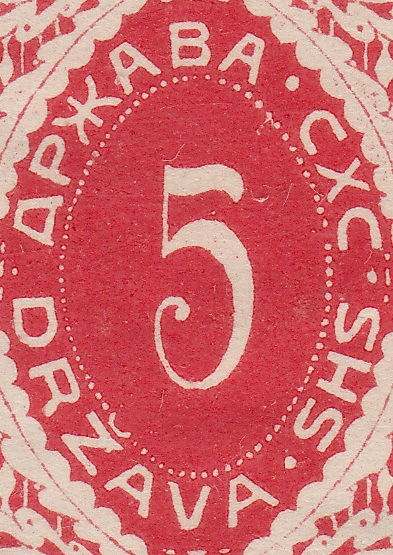 |
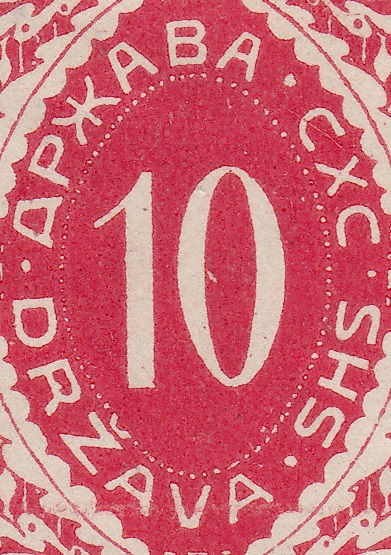 |
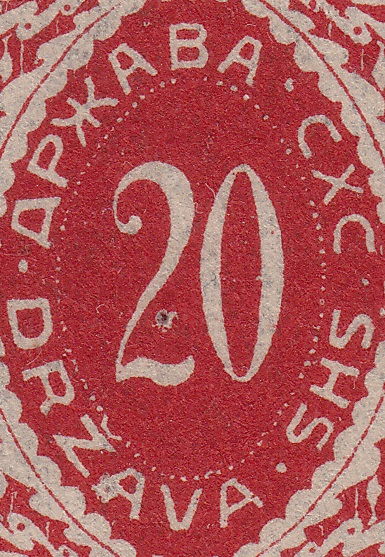 |
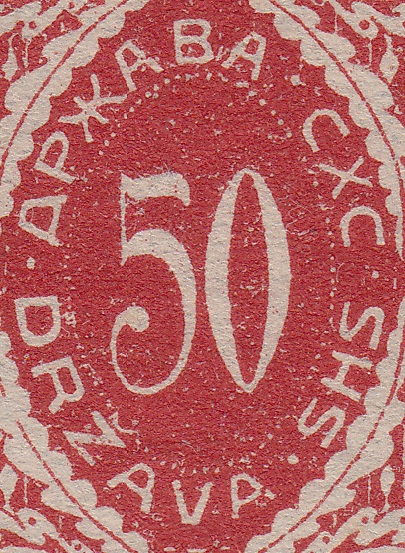 |
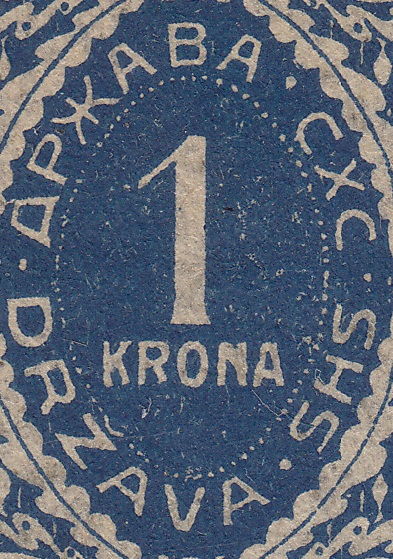 |
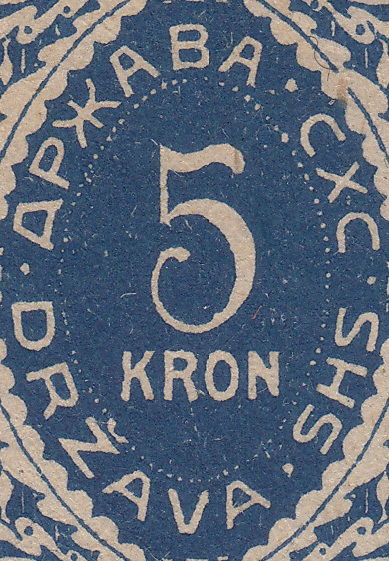 |
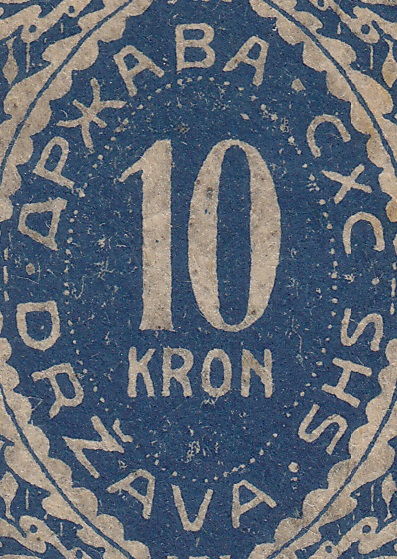 |
| Details | Details | Details | Details | Details | ||
| Vienna print | ||||||
|---|---|---|---|---|---|---|
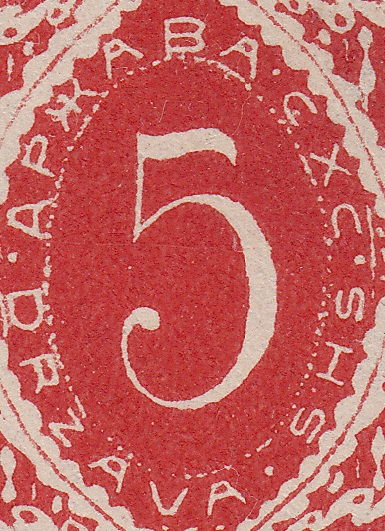 |
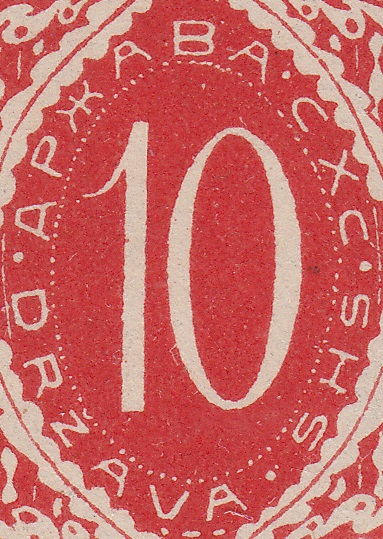 |
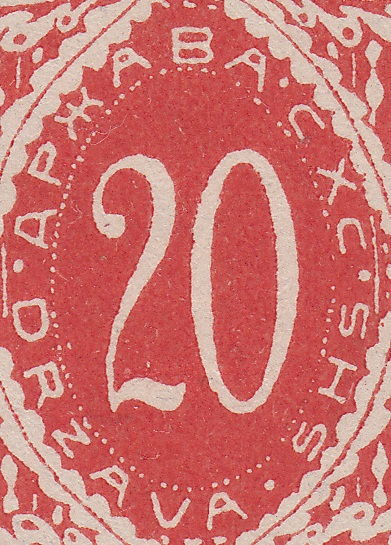 |
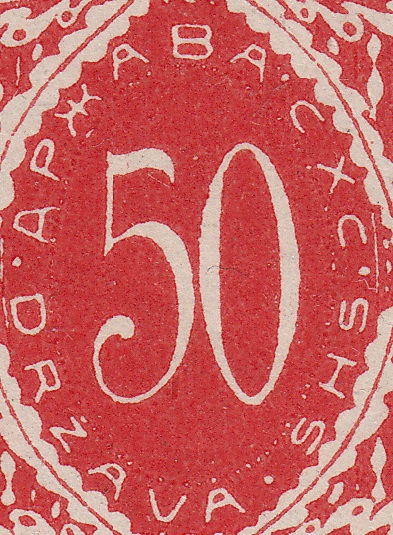 |
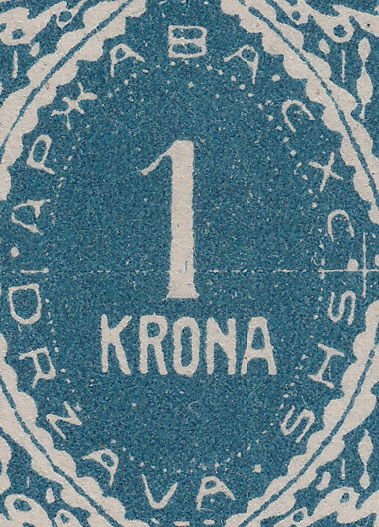 |
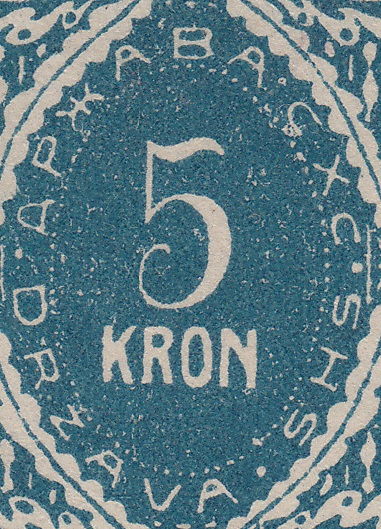 |
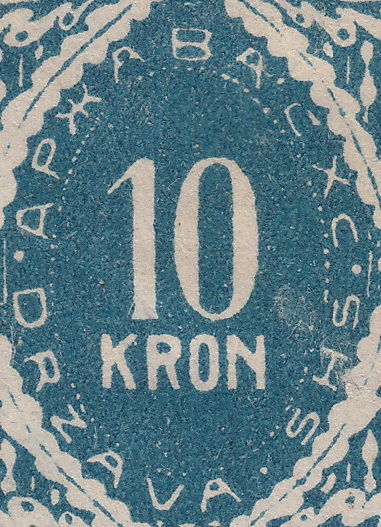 |
| Details | Details | Details | Details | |||
B. Provisional issue, denomination in dinars
On 5 July 1920, a provisional issue of postage dues came into circulation. Stamps of 15 (blue) and 30 vinar (red) of both lithography and letterpress issues were overprinted with the same overprint. Stamps were overprinted in letterpress by Jugoslovanska tiskarna in Ljubljana.
| Overprints | ||||||
|---|---|---|---|---|---|---|
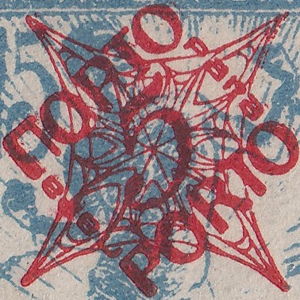 |
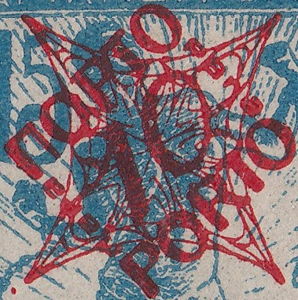 |
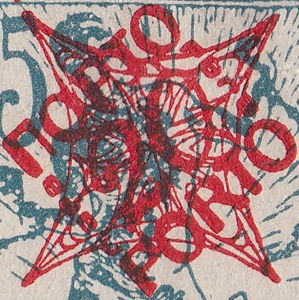 |
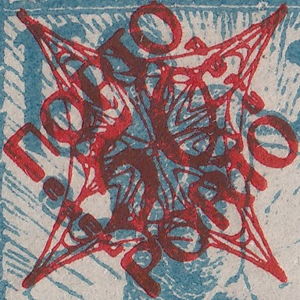 |
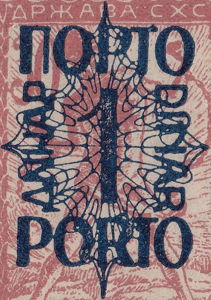 |
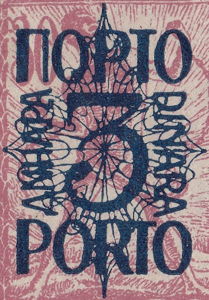 |
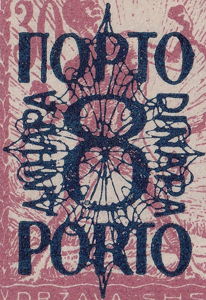 |
Layout of overprints
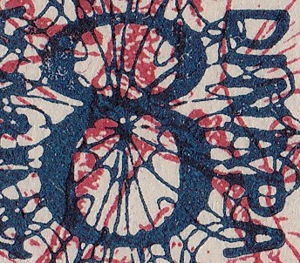 |
| An interesting design error appears on all stamps with 8 dinara overprint: inscription reads DINAPA instead of DINARA. |
- 15 vinar stamps in sheets of 100 were overprinted with para denominations in red color. Every sheet contained all para values (click here for an example):
- 30 stamps of 5 para,
- 10 stamps of 10 para,
- 30 stamps od 20 para and
- 30 stamps of 50 para.
- 30 vinar stamps in sheets of 100 were overprinted with dinar denominations in dark blue color. A sheet contained:
- 50 stamps of 1 dinar,
- 30 stamps of 3 dinar and
- 20 stamps if 8 dinar.
Circulation
| Number of stamps by prints and denominations | ||||
|---|---|---|---|---|
| Denomination | Lithography 11½ Blaznikovi nasledniki |
Letterpress rouletting Jugoslovanska tiskarna |
Letterpress 11½ A. Reisser |
Total |
| 5 para | 720.000 | 420.000 | 56.200 | 1.196.220 |
| 10 para | 240.000 | 140.000 | 18.740 | 398.740 |
| 20 para | 720.000 | 420.000 | 56.220 | 1.196.220 |
| 50 para | 720.000 | 420.000 | 56.220 | 1.196.220 |
| 1 dinar | 300.000 | 300.000 | – | 600.000 |
| 3 dinar | 180.000 | 180.000 | – | 360.000 |
| 8 dinar | 120.000 | 120.000 | – | 240.000 |
Newspaper tax stamps
Newspaper tax stamps were also used on the whole territory of the State of Slovenes, Croats, and Serbs. On 2 September 1920, one part of these stamps was overprinted in new state currency as a provisional issue. In September and October 1920, these stamps were overprinted to commemorate the Carinthian Plebiscite.
The stamps were not extensively used since in 1920 flat rate fees were introduced for newspapers. From 15 June 1921, postage fees for newspapers were paid in cash for domestic shipments and in regular postage stamps for sending abroad.
Stamps were printed only in lithography technique, both in Ljubljana by press Tiskarna Blaznikovi nasledniki (issued on 15 May 1919) and in Vienna by A. Reisser (issued on 15 November 1919). All denominations were printed on one press sheet. Perforation was applied only between different denominations in order to create sheets of stamps.
| Characteristics of prints | Ljubljana print | Vienna print | |
|---|---|---|---|
| Papers | A. Rough with net structure, thickness 0.05 – 0.09 mm. | 2, 4, 6, 10, 30 vinar | – |
| B. Smooth, white, no structure, thickness 0.06 – 0.10 mm. | – | 2, 4, 6, 10 vinar | |
| B1. Smooth, white with structure (network) | – | 2, 4, 6, 10 vinar | |
| C. Porous with minuscule pores (nonuniform), thickness 0.07 – 0.09 mm. | 2, 4 vinar | – | |
| C1. Porous, striped | 2, 4, vinar | – | |
| D. Rough yellowish, with structure (network) with color fibers | – | 2, 4, 6 in gray color 2, 4, 6, 10 vinar in blue color |
|
| D1. Bluish gray, rough, with structure, sometimes with color fibers | – | 2, 4, 10 vinar | |
| D2. Bluish gray, smooth, with structure, with color fibers | – | 2, 4, 10 vinar | |
| Gum | Yellowish | White | |
| Fine, thin lines | Rough, disconnected lines | ||
| Distance between stamps in a sheet | 3 : 3 mm | 3,5 : 4 mm | |
Differentiating between Ljubljana and Vienna prints
| Ljubljana print | ||||
|---|---|---|---|---|
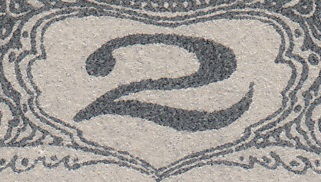 |
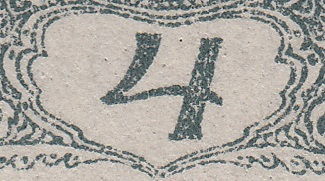 |
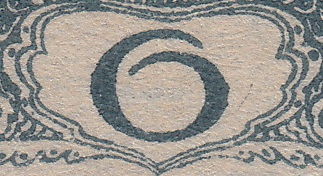 |
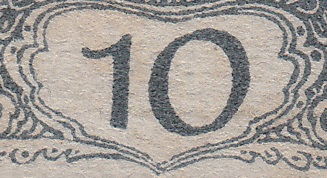 |
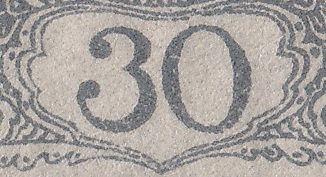 |
| Details | Details | Details | ||
| Vienna print | ||||
|---|---|---|---|---|
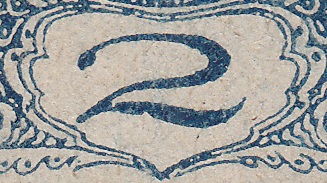 |
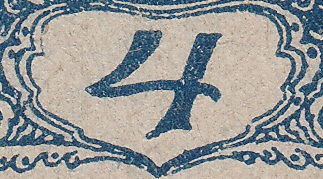 |
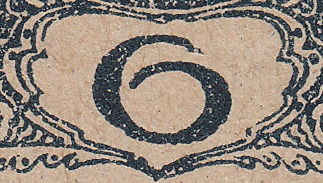 |
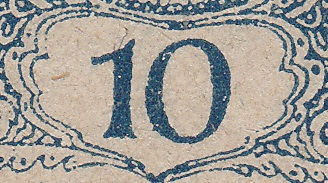 |
30 vinara stamp was not printed in Vienna |
| Details | Details | |||
B. Provisional issue, denomination in dinars
On 2 September 1920 a provisional issue of newspaper tax stamps was issued. 2 vinar stamps of Ljubljana and Vienna prints were overprinted in black color with new value in dinars. Stamps were overprinted in Jugoslovanska tiskarna in Ljubljana.
The overprint
Sheets of Ljubljana and Vienna printed stamps were overprinted with the same form, although the distance between stamps in sheets varies between the two prints. To overcome this problem two sets of overprint forms were created and then joined together: “group of forms A” (5 x 10) intended to overprint the left part of the sheet while the “group of forms B” intended to overprint the right side of the sheet. There are noticeable differences between the two forms which makes 2 types of each overprint (see the table below).
When overprinting stamps of Vienna print, both groups of forms were fixed wider apart to reduce shifts in overprints. It so happened that the forms were fixed in BA layout instead of AB, which means that in the case of stamps of Vienna print, form B was used to overprint the left side, while form A was used to overprint the right side of a sheet.
Note: there’s a design error on overprints of 2 and 4 para. In order to be grammatically correct, the wording should be “pare”, not “para”.
Layout and perforation
The original sheets consisted of 100 (10 x 10) stamps. Every overprinted sheet contained overprinted stamps of all 5 values:
- top 3 rows with 2 para,
- next 3 rows with 4 para,
- 7th and 8th row with 6 para
- 9th row with 10 para,
- the last, 10th row, with 30 para overprint.
Originally, newspaper tax stamps were printed imperforated. Since all 5 values were printed on one sheet, they were separated with perforation line 11½.
Carinthian plebiscite edition
To commemorate the Carinthian Plebiscite, 2 and 4 vinar newspaper tax stamps of Ljubljana issue were overprinted in red color and denomination in dinars. The abbreviation KGCA stands for “Koroška glasovatelna cona A” (Carinthian Voting Zone A).
Stamps were sold in sets at 3-times denomination price and were in use until 31 October 1920 on territories of Slovenia, Croatia, Bosnia and Herzegovina, and Vojvodina. Money collected from the sales of stamps was donated to the Slovenian propaganda committee for Carinthia.
Sheets of stamps were overprinted in a way that they contained overprints of different denominations:
-
- 4 vinar, Ljubljana print 10 x 10 sheet contained: 10 x 4 stamps of 5 para, 30 x 3 stamps of 15 para, 10 x 3 stamps of 25 para. 11.960 sheets were overprinted.
- 2 vinar, Ljubljana print 10 x 5 sheet contained: 15 stamps of 45 para, 30 stamps of 50 para, 5 stamps of 2 dinara. 11.888 sheets overprinted.
- 2 vinar, Ljubljana print 10 x 5 sheet contained: 40 stamps of 2 dinars and 10 stamps of 45 dinars. 740 sheets overprinted.
| Overprints only on Ljubljana issue | |||||
|---|---|---|---|---|---|
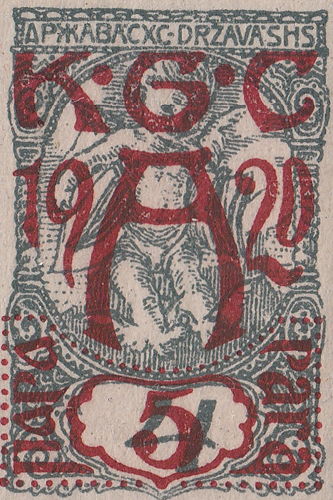 |
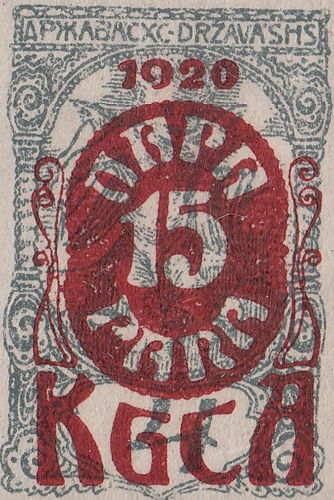 |
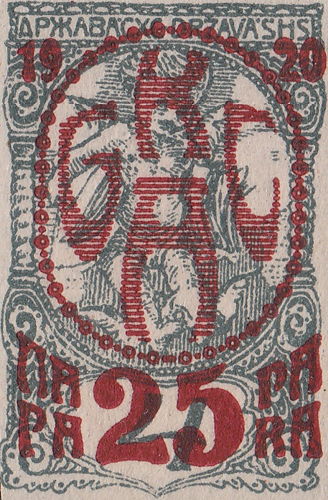 |
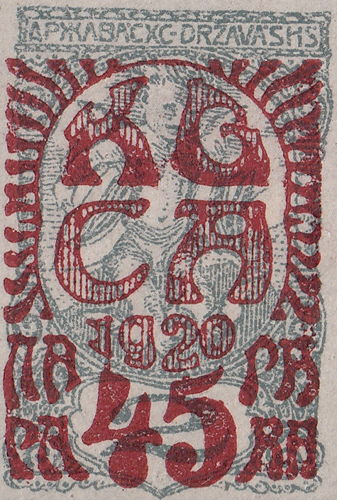 |
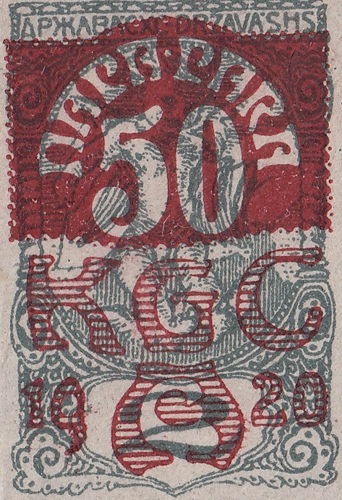 |
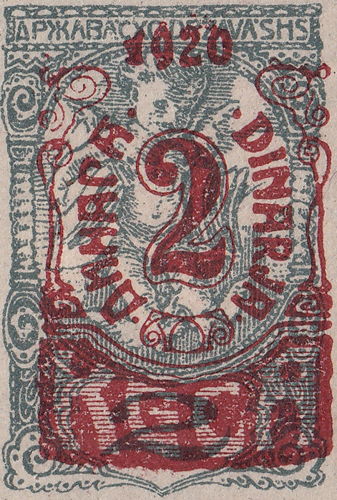 |
A distinct category in the postmark collection includes postmarks from the Carinthian and Styrian post offices, which came under Austrian jurisdiction after the 1920 plebiscite.
The so-called “Celje issue”
Introduction
In May 1919 a group of private investors came up with an idea to overprint Austrian stamps issued in the years 1916/17 to commemorate the creation of the State of Slovenes, Croats, and Serbs. A consortium was established for this undertaking.
Original stamps were got either from post offices in Slovenia, seized stamps from Carithia or by buying remaining stocks in Vienna. Complete sheets were not available anymore so it was decided to overstamp fragments and individual stamps by hand.
It is unclear at which stage the Postal Directorate in Ljubljana got involved but it is known that overstamping took place in its premises. As it didn’t have the authority to issue stamps the Postal Directorate in Ljubljana asked for approval from the competent ministry in Belgrade. The initiative was rejected, and the existing stock was counted and sealed.
 |
| Signature Apenik on the back of the stamps. |
It is unknown how stamps came to the market. Some sources state that the consortium of investors sued the state as they claimed compensation for their investment that was backed by the official institution (Postal Directorate in Ljubljana). These sources also mention that stamps were handed over to the consortium after it won the juridical procedure. Other sources state that after 2 November 1921, when stamp issues of Slovenia lost validity, the whole remaining stock of stamps was sold at an auction.
Whatever the truth a part of this issue came to the hands of a prominent stamp dealer who stamped his signature APENIK on the back of the stamps. The dealer, Mr. Repernik, was from city of Celje – hence the name of “Celje issue”.
These stamps were never in circulation. Used stamps are either forgeries or (according to some testimonies) essays, as unused stamps were available only in low quantities saving measures were introduced.
List of overprinted values
In total 27 stamps were overprinted with black, blue, and red overprints. Note: strong offsets on stamps’ backs are common on red overprints. Blue and red overprints are fuzzy and mostly of type II.
Overprints on 10 krone stamps, printed on silk-thread paper are forgeries.
| DEFINITIVE ISSUE | ||||
|---|---|---|---|---|
| Denomination | Circulation | Overprint black | Overprint blue | Overprint red |
| 3 vinar | 7.175 | Link | – | – |
| 5 vinar | 13.000 | Link | – | – |
| 6 vinar | 17.050 | Link | – | – |
| 10 vinar | 2.000 | Link | – | – |
| 12 vinar | 7.020 | Link | – | – |
| 15 vinar | 10.591 | Link | Link | – |
| 20 vinar | 15.000 | Link | Link | – |
| 25 vinar | 7.530 | Link | – | Missing |
| 30 vinar | 7.336 | Link | Link | – |
| 40 vinar | 6.800 | Link | Link | Link |
| 50 vinar | 6.837 | Link | Link | – |
| 60 vinar | 6.831 | Link | – | Link |
| 80 vinar | 6.800 | Link | Link | – |
| 90 vinar | 6.897 | Link | Link | – |
| 1 krone | 6.806 | Link | Link | – |
| 2 krone | 6.848 | Link | Link | – |
| 3 krone | 1.307 | Link | – | – |
| 10 krone | 109 | Link | – | – |
| DEFINITVE ISSUE: NEW VALUES | ||||
| 10 vinar on 5 vinar | 12.000 | Link | – | – |
| 3 krone on 1 krone | 6.800 | Link | – | – |
| 4 krone on 1 krone | 6.805 | Link | – | – |
| 10 krone on 1 krone | 6.800 | Link | – | – |
| SPECIAL DELIVERY STAMPS | ||||
| 2 vinar | 10.000 | Orientation 1 Orientation 2 |
– | – |
| 5 vinar | 10.000 | Orientation 2 | – | – |
| POSTAGE DUES | ||||
| 5 vinar | 10.000 | Link | – | – |
| 10 vinar | 10.000 | Link | – | – |
| 15 vinar | 10.000 | Link | – | – |
Types of overprints
Contemporary forgeries
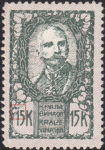 |
| Sharp and regular perforation instantly gives away a Padevet forgery |
The Padevet forgeries
When printing of 15 and 20 krone stamps by press “Tiskarna Blaznikovi nasledniki” in Ljubljana was completed an employee of the press managed to obtain either printing plates or lithographic paper for each stamp.
The employee mentioned this to his friend Mr. Padevet, who was a lithographer by profession. The latter got in contact with stamp dealers Ivan Jurca and Mate Simončič, both from Ljubljana. As these stamps and their varieties were sought for on philatelic market they decided to forge them.
They bought the stolen materials from the employee of the press for a sum of 15.000 krone and got to work. Mr. Padevet created new plates for printing sheets of 16 stamps (8×2). When the work was done Mr. Jurca and Mr. Simončič started selling them.
The wrongdoing came to light when another stamp dealer, Franjo Počkaj, in 1922 found out that a large quantity of these stamps is being sold at an auction house in Vienna. Also, he found out that another stamp dealer bought 1.500 complete sets from Mr. Jurca and Mr. Simončič. The affair ended in the courtroom where the perpetrators received jail sentences.
The most prominent features of Padevet forgeries are:
- both values: sharp and regular perforation,
- 15 krone stamp: white circle on top of left numeral 1,
- 20 krone stamp: indentation in the right frame.
Other features:
- brighter colors
- clearer print
- thicker paper of better quality
- the pale color of background lines that appear to be inverted (best visible between the king’s shoulder and head)
The Sunday Edition
The origin of the “Sunday Edition” stamps, as they were later named, was never determined and offenders were never identified. Early philatelists noted differences between sheets of stamps, some having different numbers and layouts of known varieties. At first, it was assumed there were two runs that were printed on the same type of paper and gum and had the same type of perforation.
| Differences between stamps and sheets of the official issue and the Sunday Edition | |||
|---|---|---|---|
| Official issue | Sunday Edition | ||
| Colors | clean and sharp | pale and blurry | |
| Gum | smooth | mostly bubbly | |
| 15 krone sheet | “Curved 5” Variety | once | 37 times |
| 20 krone sheet | “Teardrop” Variety | once | once |
| “Kralevina” Variety | once | 21 times | |
| “Small Ks” Variety | 5 times | 25 times | |
Later, the “second run” was regarded as “unofficial” and it was assumed that its printing was ordered by one of the directors of the Postal Directorate in Ljubljana for philatelic purposes only and that the stamps of this “unofficial issue” were, for some unknown reason, mixed up with the “official issue” and sold regularly at post offices.
This version of events was denied by the Postal Directorate as no documents for printing the second run existed, personnel in charge also denied any involvement.
The latest version of events was that the stamps were printed without any authorization by the unknown employee(s) of the press on a Sunday preceding public holidays (hence the name of this issue), when the press was closed. Then they created new plates and printed about 100 sheets of 144 stamps, one part of these they mixed up with genuine stamps so that it would seem that their product is legal (as it originated from the press and distributed to post offices through official channels).
Contemporary specialists judged this version of events as impossible. What really happened in the press that Sunday will probably forever remain a mystery.
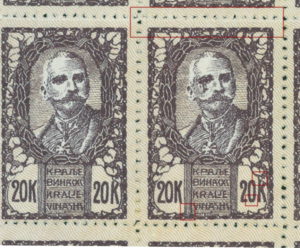 |
| Features revealing a genuine “Teardrop” flaw. |
Forged “Teardrop” flaw
The “Teardrop” plate flaw appears only once in a sheet, on the 28th field. The variety is quite rare and sought for on the philatelic market. A number of forgeries are produced by additionally imprinting the teardrop on a genuine stamp. When observed closely, the forged teardrops differ in appearance from the originals, some are even not well-centered and can be shifted in all directions.
As the “Teardrop flaw” appears only once in a sheet and the stamps of this issue exhibit many types and marks (literally, every stamp in a sheet is different), it is easy to determine which stamps are genuine. The following features are typical for the 28th stamp, if the stamp exhibits all of them, then it’s genuine:
- letter K on the right side touches the lime leaf on top,
- the third vertical line of the box with the country name is broken at the bottom,
- the wavy background is horizontally broken at the top of the stamp,
- zero of the right denomination value is flat at the bottom.
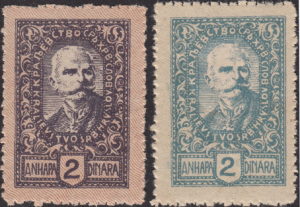 |
| Artificially altered color (right stamp). |
Color alterations
Due to post-war shortages and haste in preparations, the Chainbrakers issues represent a philatelically incredibly rich area. Different paper and gum types, perforations, paper techniques an abundance of printing errors, plate flaws, and unusual postal usages soon found interest in collectors all over the World.
Already in the late 1920s, the philatelic market swarmed with forged and altered stamps which led to confusion in collectors and specialists alike. It was noted that many stamps changed in appearance when exposed to humidity for a longer time. This occurrence was attributed to the low quality of materials that were used in the production of stamps.
Awareness of these effects prompted some schemers to invent other means to artificially change the appearance of stamps and create “to this date unknown varieties” that would attract collectors. Exposing stamps to direct sunlight and dipping them in acids left marks on paper and gum and were therefore easily recognizable by experienced collectors.
But in 1930s more dangerous color manipulations appeared. The so-called “Kaufmann’s colors” were convincing even to experienced philatelists. No traces of manipulation were to be seen on gum or on paper. Most of them originated from stamp dealer Mr. Kaufmann from Vienna who also stamped his signature “K” on the back of the majority of stamps he sold. The fierce debate followed in philatelic circles whether these stamps truly were rare color varieties or just artificially altered stamps. The secret was soon revealed: the forger carefully placed a piece of glass over stamps and exposed them to sunlight for a day or two. The colors changed leaving paper and gum intact.
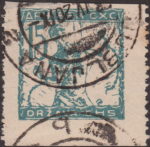 |
| Stamps with wide margins offer enough space to forge a perforation |
Perforation forgeries
Production difficulties in printing Chainbreakers stamps manifested also in uneven perforations. In one and the same sheet, one could find stamps with extremely wide margins and stamps where perforation literally cut into the design. Apart from these, imperforate and part imperforate stamps were circulated.
These deficiencies in production prompted some schemers to produce their own varieties of perforations and offer them on the philatelic market. Contemporary specialists listed these perforations as fraudulent:
- 12½,
- 12½ : 11½,
- 11½ : 12½,
- and the above-mentioned combinations with rouletting.
 |
| A genuine stamp. |
The Brussels forgery of 20 para stamp
The 1920 issue of postage stamps, denominated in dinars, was in circulation for only about 6 months. The stamps were issued on 24 June 1920, but on 16 January 1921, a general issue for the whole territory of the Kingdom of Serbs, Croats, and Slovenes was issued.
Unsold stock was huge and it was sold at an auction in 1922, together with other regional issues. Buyers of this stock didn’t find the 20 para stamp as only 205.000 of them were printed and the majority of them were in the hands of one local stamp dealer.
As the buyers were left without complete sets they decided to print in Brussels (Belgium) a sufficient quantity of 20 para stamps. These differ from the originals in:
| Differences between genuine and forged stamps | ||
|---|---|---|
| Genuine stamp | Forged stamp | |
| Overall size | 19½ : 29½ | 21½ : 30½ (an extra tooth of perforation) |
| Color | carmine | brick red |
| Paper | regular | thicker and harder |
| Typography | regular | letters thinner and smaller |
| Distance between stamps in a sheet | 2 mm | 4 mm |
Interestingly, the counterfeiters were able to obtain an original postmark ZAGREB D 1 D 921 NOV. 19 which they used in creating used stamps.
References
Bibliography
-
- Fleck, Vladimir (1940): Priručnik Maraka Hrvatskih Zemalja, Book 1, Tome 4, Hrvatski Filatelistički Savez, Zagreb
- Fleck, Vladimir (1946): Priručnik Maraka Jugoslavenskih Zemalja, Book 1, Tome 5, Hrvatski Filatelistički Savez, Zagreb
- Fleck, Vladimir (1946): Priručnik Maraka Jugoslavenskih Zemalja, Book 1, Tome 6, Hrvatski Filatelistički Savez, Zagreb
- Fleck, Vladimir (1947): Priručnik Maraka Jugoslavenskih Zemalja, Book 1, Tome 7, Hrvatski Filatelistički Savez, Zagreb
- Vardjan, Miran (?): Celjska izdaja – predhodnica verigarjev?
- Velikanje, Jože (2000): Slovenika 2000, katalog poštnih znamk, celin, žigov in telekartic Telekoma Slovenije. ISSN 1408-2209.
Contributors
Some of the images in the Chainbreakers section were contributed by:
- mag. Boštjan Petauer FRPSL

